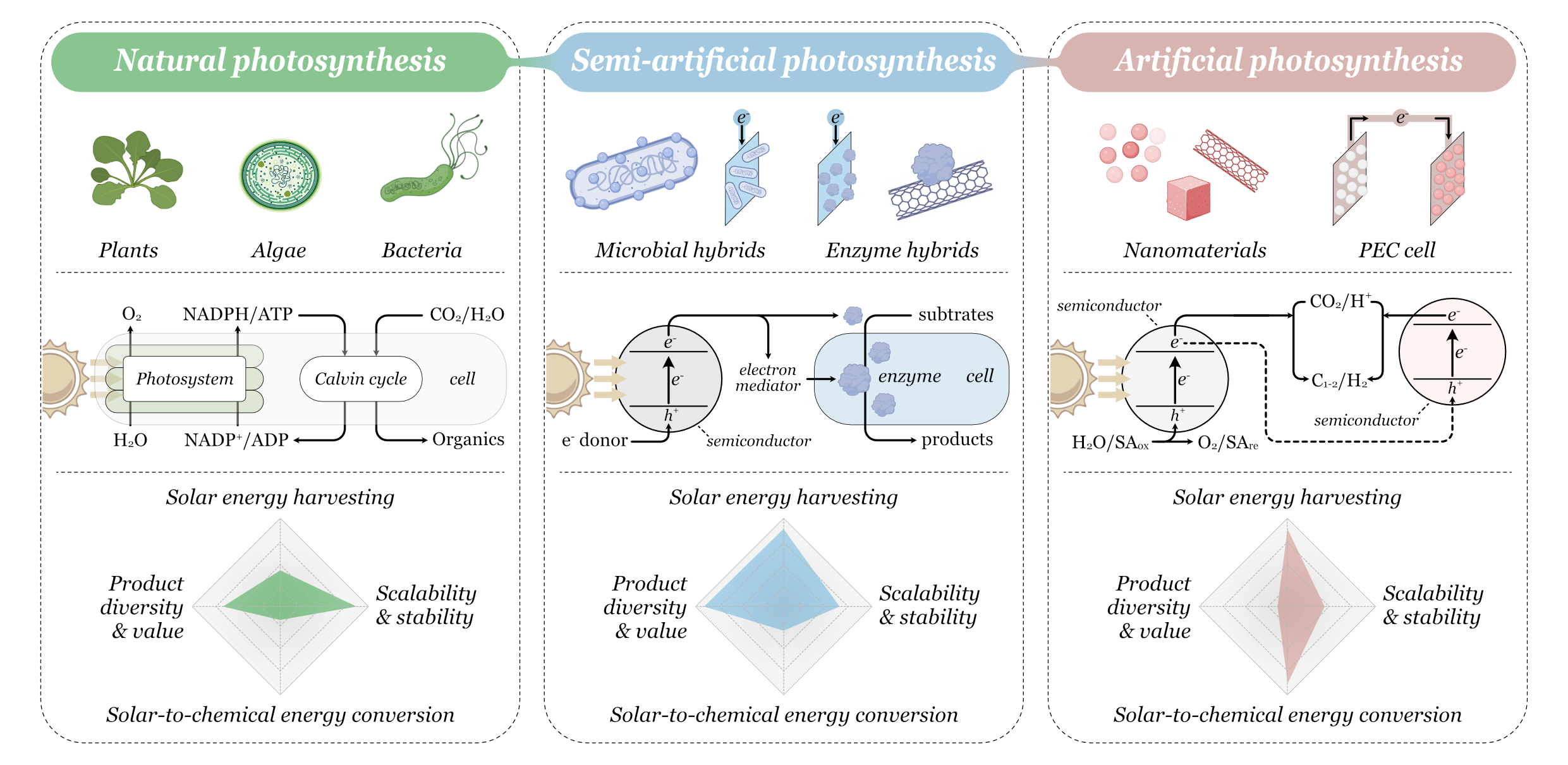
On June 21, 2024, the teams led by Wang Bo, Gao Xiang, and Zhong Chao from the Material Synthetic Biology Research Center of the SIAT (hereinafter referred to as "SIAT Material Center") jointly published a review article titled "Revisiting solar energy flow in nanomaterial-microorganism hybrid systems" online in the renowned international academic journal Chemical Reviews. The article discusses the process and mechanisms by which nanomaterial-microorganism hybrid systems capture solar energy and convert it into chemical energy at a systematic level. It analyzes and summarizes the significant progress and challenges faced by research in this area, while contemplating future development directions and potential applications.

Screenshot of the article online
Link:https://pubs.acs.org/doi/10.1021/acs.chemrev.3c00831
The team led by Wang Bo had previously published a review article to review and predict the progress in the field of semi-artificial photosynthesis (Energy Environ. Sci. 2022, 15, 529-549). This article provides a deeper understanding, contemplation, and summary of this field.
In today's society, the demand for sustainable development is continuously increasing. The semi-artificial photosynthesis system is one of the diverse strategies for utilizing solar energy that has emerged in recent years. This system combines the advantages of both natural and artificial photosynthetic systems (Figure 1) and holds significant potential value in clean energy production, carbon reduction, and green chemical manufacturing. In comparison, semi-artificial photosynthesis systems constructed based on nanomaterial-microbial hybrid systems (Nanomaterial-microbial hybrid system, NMHS) have the most development potential.

Figure 1. Main characteristics and unique advantages of natural photosynthesis, semi-artificial photosynthesis, and artificial photosynthesis systems
Although the research progress in this field is rapid, the vast majority of successful NMHS examples have not been applied practically due to their poor energy conversion efficiency. The main reason is the lack of systematic understanding and analysis of the complex and transient internal energy flow processes in NMHS, making it difficult to undertake system design and optimization. In this review, we sort out the internal energy flow process of NMHS (optical energy capture-transmembrane energy transfer-energy conversion) and propose reasonable optimization schemes for the current research challenges.
In the optical energy capture stage, semiconductor nanomaterials absorb photon energy to excite photoelectrons. Photoelectrons are directly or indirectly used by microbial cells to drive chemical production. The band structure of nanomaterials determines the material's light capture range and photoelectron catalytic activity (Figure 2). The optimization strategy for this stage should comprehensively consider lighting conditions and material biosafety, including adjusting material band structures to optimize light capture range and catalytic activity, enhancing material and cell light tolerance levels to adapt to higher light intensities, and optimizing nanomaterial biosafety to reduce its damage to microorganisms. In the transmembrane energy transfer stage, the optical energy captured by nanomaterials needs to cross the cell membrane into the cell to drive metabolic reactions. This stage's optimization work should fully focus on the material and cell binding methods (extracellular suspension, surface adhesion, entry into cells) and energy transmembrane transfer modes (direct electron transfer, with the help of electron mediators or hydrogen, etc.). Optimization strategies include constructing artificial transmission pathways for efficient energy transmembrane, strengthening the combination degree between materials and cells (adhesion or intracellular enrichment), alleviating the impact of intracellular materials on microbial activity, and building a high specificity affinity between intracellular materials and target enzymes. In the energy conversion stage, microbial cells convert and store the photoenergy into the chemical bond energy of product molecules through enzyme catalysis. Target enzymes driving key metabolic pathways can obtain energy from cofactors (NAD(P)H or ATP), nanomaterials, or carriers. The optimization strategy for this stage should focus on reducing energy dissipation, including enhancing the efficiency of microbes in utilizing cofactors, strengthening the overall microbial metabolic activity towards specific carriers (such as H2 and formic acid), and building high-specificity energy transmission and conversion pathways between materials and target enzymes.

Figure 2. Band structure of semiconductor nanomaterials in typical reported NMHS
We also systematically analyzed the challenges faced by current NMHS and proposed corresponding solutions, including using modern instrumental analysis techniques, synthetic biology, high-throughput and automation, machine learning, and artificial intelligence to achieve efficient operation of the entire process from mechanism analysis, system design, experimental operations to data analysis (Figure 3).

Figure 3. Strategies for systematic optimization of energy flow in NMHS
Summary and Outlook: NMHS has the potential to become a clean platform for solar-driven chemical production, which is crucial for promoting energy structure transformation and achieving sustainable development in human society. Through this review, we have revisited the latest research progress in this field, clarified the challenges faced by subsequent development of NMHS, and proposed system-level solutions and optimization strategies. Modern technological means represented by synthetic biology can empower NMHS at key links such as improving product value, enriching product diversity, and optimizing microbial production efficiency, thereby effectively promoting the continuous iterative evolution of the system. A set of NMHS with practical application value needs to organically integrate and fully coordinate all favorable factors, and the successful implementation of efficient energy flow is the cornerstone for NMHS to move from the laboratory to industrial production.
Researchers Zhong Chao, Wang Bo, Gao Xiang, and Assistant Researcher Zeng Cuiping from the Material Synthetic Biology Research Center of the SIAT (hereinafter referred to as "SIAT Material Center") are the corresponding authors of this article. Assistant Researcher Liang Jun of SIAT Material Center, Doctor Xiao Kemeng of the Department of Chemistry, Chinese University of Hong Kong, and Associate Researcher Wang Xinyu of SIAT Material Center are the co-first authors. Assistant Researcher Hou Tianfeng of SIAT Material Center also made significant contributions to the writing of this article.
This study was supported by the funding from the Key Research and Development Program of the Ministry of Science and Technology, National Natural Science Foundation, Shenzhen Key Laboratory for Material Synthetic Biology, Guangdong Basic and Applied Basic Research Foundation, Shenzhen Natural Science Foundation, Shenzhen Institute of Synthetic Biology, etc.